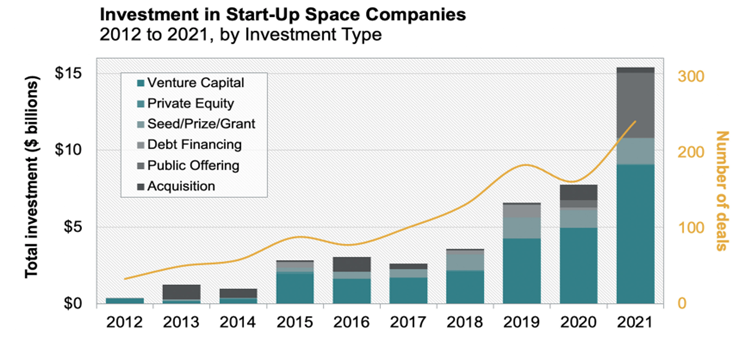The New Economy of New Space


Hakan Savaşan
Chief Technology Officer
In May 2020 the space economy crossed a new and very important threshold when a private company succeeded in sending humans into space with its own resources and technology for the first time in human history. The space race, which began after World War II, evolved into an international cooperation in space at the end of the Cold War in the early 1990s. Private sector initiatives, which increased in number every day in the 2000s, succeeded in commercializing the industry that is being dominated by government agencies and states. Today, we live in a new space economy worth billions of dollars, where private companies producing their technology, almost without the need for states and public funds, have taken the lead.
It is useful to remember how things work in the so-called “traditional” space economy, to be able to define the new space economy. In this traditional model, government agencies or very large government-like organizations call for tenders with technical and legal specifications that define the space mission they need.
Traditional giant space companies compete by bidding to get these tenders. The company that offers the best performance at the lowest price wins the contract, executes the mission, and receives payments for work done at specific milestones. Meanwhile, they work with smaller, specialized companies within a large ecosystem. The existing business model we all know well. However, the new space economy companies have innovative structures that go far beyond this understanding. Their products, technologies, business models, processes, financial structures, and market perspectives are very different from those of the traditional space industry’s large and deeply entrenched players. To understand the difference, it is useful to examine two different organizations that provide a service widely used in the space industry in line with the traditional and new space economies.
Traditional space versus new space
Earth observation is one of the most important services in the space industry. Of the $118 billion in revenue generated by all space-based services in 2021, $2.7 billion is attributable to these services. The European Union has long implemented the Copernicus program to meet its intensive needs in this area and to provide a sustainable and cost-effective service to its stakeholders. The program, which is entirely focused on the traditional space economy, is funded and managed by the European Commission for the European Union (EU) in collaboration with partners such as ESA and EUMETSAT. The program is supported by several program-specific satellites and various commercial and public satellites known as the Sentinel family.
Planet Labs, on the other hand, is a San Francisco-based, privately held company that provides nearly all its services commercially to the public and private sectors under the Copernicus program. The company uses over two hundred cube satellites, designed, and manufactured in-house, equipped with powerful telescopes and cameras to support its daily operations. Unlike the non-profit Copernicus program, which relies on EU funding to ensure its continued existence, The Planet must use its resources and continually generate profits to survive. This situation requires the company to be more agile in its day-to-day operations with far fewer staff, offering cost-effective products and services with innovative business models to meet the diverse needs of different customers promptly.
This is where adaptation to the new economy of the new space is evident. For example, the company applies a fourteen-day introductory program to its customers who want to receive its services. Under this program, potential customers are trained to use the company’s services efficiently and at the lowest cost.
Investments in space startups rise sharply
Investment in the startups of the new space age, which is considered to have started with the funding of one of today’s famous companies, SpaceX, by private sector investors in 2002, has increased dramatically over the last decade, reaching a total of $23 billion, with a new record set in the last two years.

Source: BryceTech Startup Space Report 2022
It is possible to divide new space companies into two basic categories, depending on the products and services they offer: space for Earth and space for space:
- Space for earth economy includes goods and services in space (telecommunications and Internet infrastructure, Earth observation capabilities, national security satellites, etc.) produced for use on Earth. Of the estimated $366 billion in revenue generated by the space industry in 2019, this sector accounts for 95%, and this number is expected to grow.
Space economy for space includes goods and services produced in space for use in space (commercial space stations, production in space, maintenance and service in orbit, space garbage collection, etc.). High radiation, non-gravity environment and high vacuum in space conditions promise new horizons especially in R&D studies. However, the majority of startups in the space economy for space provide products and/or services to other startups, which is one of the key vulnerabilities of the industry that can trigger a domino effect. It is speculated that a significant number of startups may end their commercial life in 2023.
Everyone is optimistic for the future
The space economy, until recently dominated by government institutions, has become a niche sector in which private capital can find a place, thanks to the complex and lengthy production methods at the heart of the sector and the relative cheapness and ease of access that have resulted in recent years from technological developments in high-end propulsion and launch systems.
Experts agree on the following predictions for the future of the sector:
- Every business will be related to space in a near future. All the established industries of the world will have a presence in space.
- Governments and the public will become customers of private sector in space.
- Manufacturing in space will be real and viable.
- Today’s startups will become leaders in the space industry by 2030.
- International cooperation in space will make the world a more peaceful place.
Startups, the key players in the new space economy, are challenging the traditional space economy with their technologies, products, business processes, finances, business models, and ability to create their markets. Although there is a high probability that some of these startups will end their commercial life shortly, this seems to be beneficial and even necessary for the sector to gain a healthier structure. Because while in this process the actual technology, the product, the business model, the customer, and those who form the financial chain will survive, others will withdraw from the game, as they should, and the sector will become much more anti-fragile. What needs to be discussed is whether the new space and the new economy developing around it will be used for the long-term equality, welfare, and happiness of humanity, or whether they will create a new area of inequality that will exacerbate existing problems. We will see in a very near future.
